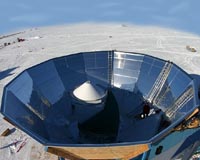|
|
|
Precise Picture Of Early Universe Supports 'Dark Matter' Theory Cardiff, UK (SPX) Nov 03, 2009  A detailed picture of the seeds of structures in the universe has been unveiled by an international team co-led by a Cardiff University scientist. The team has obtained extremely precise data about the early universe, using a telescope near the South Pole in the Antarctic. Their measurements of the cosmic microwave background - a faintly glowing relic of the hot, dense, young universe ... read more
A detailed picture of the seeds of structures in the universe has been unveiled by an international team co-led by a Cardiff University scientist. The team has obtained extremely precise data about the early universe, using a telescope near the South Pole in the Antarctic. Their measurements of the cosmic microwave background - a faintly glowing relic of the hot, dense, young universe ... read moreFermi Detects Gamma-Ray From "Star Factories" In Other Galaxies  Menlo Park CA (SPX) Nov 03, 2009
Menlo Park CA (SPX) Nov 03, 2009Nearby galaxies undergoing a furious pace of star formation also emit lots of gamma rays, say astronomers using NASA's Fermi Gamma-ray Space Telescope. Two so-called "starburst" galaxies, plus a satellite of our own Milky Way galaxy, represent a new category of gamma-ray-emitting objects detected both by Fermi and ground-based observatories. "Starburst galaxies have not been accessible in ... more
|
Vietnam says parched Red River at record low
China to be world's third biggest wind power producer: media Cost-cutting NASA eyes three cheap space missions Honduras declares state of emergency amid drought Russia in secret plan to save Earth from asteroid: official Sarkozy scrambles to salvage carbon tax French carbon tax ruled illegal Brazil's Lula signs law cutting CO2 emissions 2009 a 'benign' year of natural disasters: German re-insurer Greenpeace Spain demands Denmark release its director
| |||||||||||||||
| Previous Issues | Nov 02 | Oct 30 | Oct 29 | Oct 28 | Oct 27 |
| . |
'Ultra-Primitive' Particles Found In Comet Dust Washington DC (SPX) Nov 03, 2009
Washington DC (SPX) Nov 03, 2009Dust samples collected by high-flying aircraft in the upper atmosphere have yielded an unexpectedly rich trove of relicts from the ancient cosmos, report scientists from the Carnegie Institution. The stratospheric dust includes minute grains that likely formed inside stars that lived and died long before the birth of our Sun, as well as material from molecular clouds in interstellar space. ... more VERITAS Telescopes Help Solve Origin Of Cosmic Rays  Boston MA (SPX) Nov 03, 2009
Boston MA (SPX) Nov 03, 2009Nearly 100 years ago, scientists detected the first signs of cosmic rays - subatomic particles (mostly protons) that zip through space at nearly the speed of light. The most energetic cosmic rays hit with the punch of a 98-mph fastball, even though they are smaller than an atom. Astronomers questioned what natural force could accelerate particles to such a speed. New evidence from the ... more Spin Your Thesis! 2010 Call For Proposals  Paris, France (ESA) Nov 03, 2009
Paris, France (ESA) Nov 03, 2009ESA is offering European students the opportunity to conduct hypergravity experiments, with a call for proposals for the 2010 'Spin Your Thesis!' programme. This programme will enable university students to carry out experiments in hypergravity by using the Large Diameter Centrifuge (LDC) in ESTEC, the Netherlands. The LDC allows samples to be exposed to acceleration forces of 1-20 ... more |
. |
| . |
Mega-star explosion most distant object ever seen Paris (AFP) Oct 29, 2009
Paris (AFP) Oct 29, 2009It took 13 billion years to reach Earth, but astronomers have seen the light of an exploding mega-star that is the most distant object ever detected, two studies published Thursday reported. The stunning gamma-ray burst (GRB) was observed by two teams of researchers in April, and opens a window onto a poorly known period when the Universe was in its infancy. GRBs are the most violent ... more Opening Up A Colourful Cosmic Jewel Box  Paris, France (SPX) Oct 30, 2009
Paris, France (SPX) Oct 30, 2009The combination of images taken by three exceptional telescopes, the ESO Very Large Telescope on Cerro Paranal , the MPG/ESO 2.2-metre telescope at ESO's La Silla observatory and the NASA/ESA Hubble Space Telescope, has allowed the stunning Jewel Box star cluster to be seen in a whole new light. Star clusters are among the most visually alluring and astrophysically fascinating objects in ... more CoRoT Mission Extended Until 2013  Paris, France (ESA) Oct 29, 2009
Paris, France (ESA) Oct 29, 2009Satellite operations for the CoRoT mission have been extended until 31 March 2013. The decision by the French Space Agency, CNES, and the mission partners, including ESA, was taken on 23 October at a specially convened meeting at the CNES Headquarters in Paris. Launched in December 2006, with a nominal lifetime of 3 years, CoRoT has steadily pursued its dual mission objectives of searching ... more |
. |
| Previous Issues | Nov 02 | Oct 30 | Oct 29 | Oct 28 | Oct 27 |
| The contents herein, unless otherwise known to be public domain, are Copyright 1995-2009 - SpaceDaily. AFP and UPI Wire Stories are copyright Agence France-Presse and United Press International. ESA Portal Reports are copyright European Space Agency. All NASA sourced material is public domain. Additional copyrights may apply in whole or part to other bona fide parties. Advertising does not imply endorsement, agreement or approval of any opinions, statements or information provided by SpaceDaily on any web page published or hosted by SpaceDaily. Privacy statement |